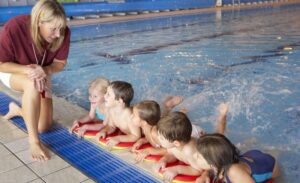
Kiddie Swimming Lessons: Getting Past Your Child’s Fears and What to Look for in Swim Lessons
So, you’re considering signing up your child for his first swimming lessons. Learning to swim not only provides kids the opportunity to enjoy lots of water-filled fun, but it’s essential to their safety. It also helps kids build strength and endurance, is an excellent form of exercise and builds kids’ confidence.
But at what age should they begin taking lessons? Little research has been done on the effectiveness of swimming lessons. Still, one small study, Association between swimming lessons and drowning in childhood: a case-control study, by R.A. Brenner, et al., has been conducted. It found that kids between the ages of one and four had an 88 percent reduced risk of drowning if they had taken swimming lessons.
In light of this information, the American Academy of Pediatrics (AAP) has updated its recommendations for children in regards to their swimming lessons. AAP News staff writer, Trisha Korioth, explains in the report, Some kids have higher drowning risk: Swim lessons add a layer of protection for all, “All parents and children over one year old should learn to swim, according to the American Academy of Pediatrics. This is especially important if your child is at a high risk of drowning.”
Korioth explains that children need to learn at least basic swimming skills. These include how to:
- Enter the water
- Turn around
- Come up to the surface
- Propel forward a minimum of 25 yards
- Climb out of the water
That said, parents must be mindful that while this reduces the risk for drowning, it doesn’t make children drown-proof. As many experts have pointed out, swimming lessons give parents a false sense of security. This actually increases kids’ risk of drowning. As it turns out, a substantial percentage of drownings occur in good swimmers and even under parents’ supervision. That’s because parents often let their guard down when their child knows how to swim.
As for the age to begin swimming lessons, many medical experts recommend against it for babies under the age of one. Infants are more susceptible to skin irritation from pool chemicals, swimmer’s ear, and hypothermia when water temperatures dip below 85°F. Also, leaky diapers in the pool increase the risk not only to your baby but to all the other swimmers of contracting a parasite. The nasty Cryptosporidium parasite causes nausea, vomiting, diarrhea, dehydration, and weight loss.
Getting Kids Used to the Water
As young children grow, they usually come to love bath time. But, as many parents can attest, getting splashed in the face is a whole different ball game for them. Add to that, a shallow bathtub is far less threatening to them than a vast, seemingly-bottomless pool. New environments, in general, can also be stressful for children. Some kids are even fearful of water. When kids sense their own parent’s fear of the water, or if the child has had a negative experience with water already, this can also add to a child’s anxiety.
Try the following to ease your kid’s fears of the water.
- Provide your child with a variety of water experiences and opportunities to get used to getting her face wet. Let your child wet and wash her own hair. In warm weather, give your youngster a kiddie pool to splash in and a sprinkler to run through.
- Read storybooks to your child about swimming and swim lessons.
- Don’t force your fearful little one into the pool. It can ultimately increase your child’s fears. At the same time, don’t make a big todo about your child’s fearfulness, either. Instead, offer encouragement and allow your kid time to warm up to the pool.
- Offer praise for each step of progress your child makes, even if it’s just dipping her feet in the water.
- Rewards can help. Offer your child an ice cream cone, park trip, or prize for taking a big step.
What to Look For in Swimming Classes
Trained instructors. Claire McCarthy, MD, in Swimming lessons: 10 things parents should know, at Harvard Health Publishing, says to look for swim instructors trained and evaluated under the guidelines of a reputable agency.
Instructor’s style. Make sure the instructor is child-centered. Teaching kids to swim is different. It requires patience, understanding, and positive reinforcement.
A warm pool. Getting into a cold pool isn’t a pleasant experience at any age. It also makes it harder to focus on learning and get comfortable in the water. Make sure the pool is heated to at least 84°F for children over six. If under three, the temperature should be at least 87°F.
Safety. Find out the class size and the ratio of students to instructors. If you won’t be in the pool with your child during the lesson, ask about lifeguards, especially if it’s a larger class. Also, do instructors get in the pool with the kids, or do they instruct from the deck?
Here are some excellent guidelines for student-teacher ratios based on the American Red Cross’s Learn to Swim program.
- Children up to four years old and attended in the pool by their parent, 12:1 ratio
- Ages three to five, with a buoyancy device, 6:1
- Kids ages six and up, 8:1; for advanced classes, 10:1
Chlorine levels. Ask if the pool chlorine and PH levels are tested regularly. Low PH causes eye irritation. Low chlorine levels can be a health risk. If you’re in doubt, pick up a test kit at a hardware store.
Open door policy. Make sure parents are allowed some ability to observe if they choose. It can be through a window or at the start or end of classes. When parents can attend the entire class, having additional eyes on the kids adds an extra layer of safety. The problem, though, is it sometimes reduces kids’ cooperation. So, decide what you’re comfortable with and what’s best for your child.





